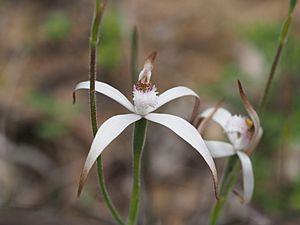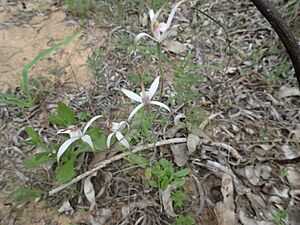Sugar candy orchid facts for kids
Quick facts for kids Sugar candy orchid |
|
|---|---|
 |
|
| Caladenia hirta subsp. hirta growing in Cockleshell Gully near Leeman | |
| Scientific classification |
|
| Kingdom: | Plantae |
| Clade: | Tracheophytes |
| Clade: | Angiosperms |
| Clade: | Monocots |
| Order: | Asparagales |
| Family: | Orchidaceae |
| Subfamily: | Orchidoideae |
| Tribe: | Diurideae |
| Genus: | Caladenia |
| Species: |
C. hirta
|
| Subspecies: |
C. h. subsp. hirta
|
| Trinomial name | |
| Caladenia hirta subsp. hirta |
|
The sugar candy orchid (also called the candy orchid) is a special plant. It belongs to the orchid family and grows only in the south-west part of Western Australia. This means it is endemic to that area.
This orchid has one leaf and usually grows up to three flowers. These flowers are creamy-white or pink. They often have brownish tips and a brown back.
Contents
Discover the Sugar Candy Orchid
The sugar candy orchid is a ground-dwelling plant. It is also a perennial, which means it lives for more than two years. It is a deciduous herb, meaning its leaves fall off each year.
This orchid grows from an underground tuber, like a small potato. Usually, you will find these plants growing by themselves.
What the Orchid Looks Like
Each sugar candy orchid has one hairy leaf. This leaf is about 60 to 200 millimeters (2.4 to 7.9 inches) long. It is also about 6 to 20 millimeters (0.24 to 0.79 inches) wide. The leaf lies flat on the ground.
The plant grows a stem that is 100 to 600 millimeters (3.9 to 23.6 inches) tall. On this stem, you will find up to three flowers. Sometimes, there can be as many as six flowers. Each flower is about 30 to 50 millimeters (1.2 to 2.0 inches) long and wide.
The flowers are creamy-white to pink on the front. Their tips are brownish, and the back of the flower is brown.
Flower Parts Explained
The top part of the flower is called the dorsal sepal. It stands straight up and is about 15 to 35 millimeters (0.59 to 1.38 inches) long. It is about 3 millimeters (0.12 inches) wide.
The side parts of the flower are the lateral sepals and the petals. They are also 15 to 35 millimeters (0.59 to 1.38 inches) long. The sepals are a bit wider than the petals. These parts first spread slightly upwards, then curve downwards.
The special lip of the orchid flower is called the labellum. It is 10 to 20 millimeters (0.39 to 0.79 inches) long and 5 to 8 millimeters (0.20 to 0.31 inches) wide. The labellum is white to pink, and its tip curls downwards.
Along the sides of the labellum, there are many small teeth. These teeth are up to 1 millimeter (0.04 inches) long. In the center of the labellum, there are four rows of pink bumps called calli.
When Does it Flower?
The sugar candy orchid blooms from late August to early November. You can often see more flowers after summer bushfires.
How it Got its Name
The sugar candy orchid was first officially described in 1840. A scientist named John Lindley wrote about it. His description was published in a book called A Sketch of the Vegetation of the Swan River Colony.
Later, in 2001, two other scientists, Stephen Hopper and Andrew Brown, described two different types (subspecies) of this orchid. One of these was the subspecies hirta. Their work was published in a scientific journal called Nuytsia.
The word hirta in the orchid's scientific name comes from Latin. It means "hairy" or "rough." This name refers to the thick hairs found on most parts of this orchid.
Where the Orchid Lives
The sugar candy orchid grows in several areas of Western Australia. You can find it between the towns of Arrowsmith and Albany.
It grows in different biogeographic regions, which are areas with similar plants and animals. These include the Avon Wheatbelt, Esperance Plains, Geraldton Sandplains, Jarrah Forest, Swan Coastal Plain, and Warren regions.
This orchid prefers to grow in woodlands and forest areas. It especially likes places that become swampy during the winter months.
Protecting the Orchid
The Western Australian Government's Department of Parks and Wildlife has classified Caladenia hirta subsp. hirta as "not threatened." This means it is not currently in danger of disappearing.


